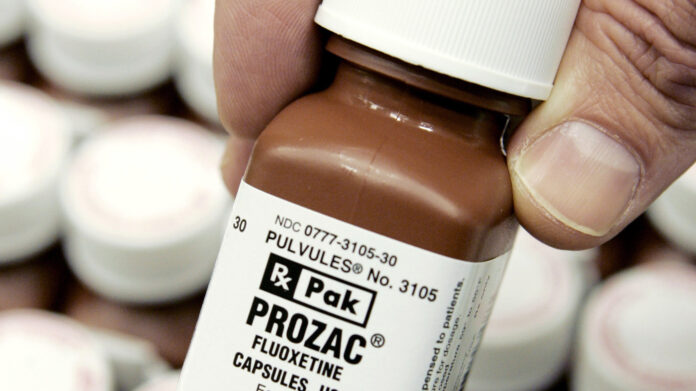
In this Jan. 11, 2008 file photo, a bottle of Eli Lilly & Co.’s Prozac is pictured at a company facility in Plainfield, Ind.
Darron Cummings/AP
hide caption
toggle caption
Darron Cummings/AP

In this Jan. 11, 2008 file photo, a bottle of Eli Lilly & Co.’s Prozac is pictured at a company facility in Plainfield, Ind.
Darron Cummings/AP
The monthly rate of antidepressants being dispensed to young people increased about 64% more quickly during the coronavirus pandemic, according to a study published Monday in the journal Pediatrics.
Researchers used the IQVIA Longitudinal Prescription Database to examine a sample of about 221 million prescriptions written for millions of Americans between the ages 12 to 25, and from 2016 to 2022. Researchers additionally separated the data into before and after March 2020, when the pandemic started.
The increase was prominent among young women and girls. The monthly rate increased about 130% faster among 12- to 17-year-old girls, and about 57% faster among young women between the ages of 18 and 25.
The study hypothesizes this jump could be due to high rates of depression or anxiety, better access to health care, due to things such as telehealth, or people’s reliance on prescriptions because of long waitlists for therapy during the pandemic.
The dataset includes prescriptions dispensed from “retail, mail-order, and long-term care pharmacies in the United States,” the study says, not exclusive health care systems, such as Kaiser Permanente.
Conversely, during the pandemic, the monthly antidepressant dispensing rate decreased for boys between the ages of 12 to 17 and did not change for young men between 18 and 25.
Though, data shows more male adolescents were sent to the emergency room for suspected suicide attempts in early 2021, compared to early 2019. Between 2019 and 2021, male high school students also reported constantly feeling sad or hopeless more often, according to the researchers.
That juxtaposition could be because men and boys are less likely to seek medical attention for their mental health, the researchers said.
The data included variables such as location, age, sex and method of payment (Medicare, Medicaid, cash, etc.), but did not include factors such as income, race or ethnicity.




